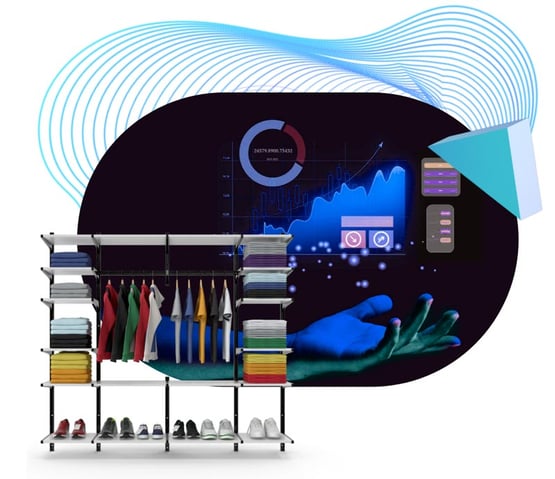What is the ROI of a PIM system?

Return on investment (ROI) is one of the most important, if not the most important, criteria for managers and executives responsible for acquiring software, as it allows the potential financial benefits and long-term value of the software to the company to be measured and assessed.
By evaluating ROI, you can make informed decisions, ensure that costly and time-consuming IT investments are aligned with strategic business goals, and deliver tangible benefits.
Product information management (PIM) systems offer considerable potential to achieve a return on investment. The results, however, will depend on various factors, such as the current state of your product data management and the technology stack, the capabilities of your internal IT team, or your data synchronisation needs. This diversity underscores that there is no one-size-fits-all simple approach to comprehensively evaluating the ROI of PIM or other enterprise solutions.
In this article, we present various criteria and guidelines to help you thoroughly evaluate the ROI of PIM. We cover topics such as quantitative and qualitative measures, time and cost savings, total cost of ownership (TCO), faster time to market and much more.
Prerequisites to Properly Assess ROI of PIM
Who Should Be Involved in an ROI Evaluation Process?
To conduct a comprehensive ROI evaluation, consultation with stakeholders from various relevant departments is essential. If you limit the ROI assessment to one or a few aspects, there is a risk that the solutions will be inadequately evaluated and the benefits for the company will not materialise.
Involving stakeholders from data management, sales, marketing, and e-commerce helps identify growth opportunities and optimise processes.

Defining Goals and Objectives
After gathering ideas and insights stakeholders, you're ready to define the problems and goals that relate to product information management in your company. These may include reducing time and costs and enhancing sales by:
-
Faster time-to-market with streamlined product onboarding and data distribution.
-
Minimizing manual data inputs.
-
Establishing a single source of truth for sales/marketing content, automating distribution across channels.
-
Improving sales processes with customized product configurations and advanced bundling strategies.
These goals aim to enhance product information management, resulting in significant time/cost savings and increased sales.
Choosing Measurements Criteria
The ROI of a PIM system, as with other software, can be comprehensively evaluated from both a quantitative and qualitative perspective, allowing for a nuanced understanding of the impact and value of investment.
The quantitative analysis concentrates on financial metrics like sales growth, cost reductions, or efficiency improvements, offering precise, measurable insights into an investment's financial performance, facilitating easier evaluation of its profitability. ROI then essentially quantifies the profit or loss relative to an investment's costs, typically presented as a percentage.
On the other hand, ROI can also be described qualitatively by taking into account non-financial factors that contribute to the overall value of an investment. Qualitative aspects of implementing PIM may include improved customer experience, a more consistent brand image, and recognition across channels, among others.
Qualitative assessments help capture more intangible benefits that may not be immediately reflected in financial statements, but are nonetheless critical to long-term success.
Quantitative Measurements and KPIs

In financial terms, return on investment involves a dual perspective: internally, the evaluation of potential cost savings, and externally, the examination of market opportunities to increase sales.
Cost Savings Related Metrics
 |
Time savings – quantify the time saved by employees due to streamlined processes or automation, and convert it into monetary value based on hourly rates. |
 |
Reduction in operational expenses and resource optimization
|
 |
Reduced Total Cost of Ownership (TCO) – takes into account the cost of the entire lifespan of software usage, including the cost of purchase, expenses associated with day-to-day use, updates, upgrades, and scaling the solution to meet growing needs. |
 |
Minimizing returns – reduce losses resulting from product returns due to incomplete, limited, outdated, or erroneous product information. |
Implementing a PIM system offers substantial cost and time savings. Let's consider the following scenario:
-
You need to onboard, enrich and publish 1000 new products annually,
-
Each SKU with an average of 10 attributes,
-
You have 2 language versions of each product,
-
All that product information needs to be distributed to 5 sales channels.
If you currently rely on manual work to manage your sales channels, and have to repeatedly update the same data, then, in the above scenario, it requires manually updating 100,000 entries per year. Assuming an average of 1 minute per entry, that amounts to 100,000 minutes, or over 1,666 hours. You can calculate the cost of one hour of tedious and to large extent avoidable work that the person responsible for this task has to go through.
And these days, the number of sales and marketing channels is ever-growing, and likely you are not using just five channels. You might be distributing product data to dozens of channels, including online and offline stores, multiple stores in various languages requiring information localization, multiple marketplaces, business partner platforms and channels, product catalogs, PPC campaigns, social media and more.
|
Important insight The crucial consideration lies not only in the quantity of SKUs and channels managed but also in the extent of your requirements for data enrichment, the number of related assets, and necessary product data relationships such as cross-selling or bundling. While an ERP system may centralize core product information like SKU, size, or weight at the backend, such raw data points alone do not suffice to create highly engaging product content for customer-facing sales channels. Furthermore, your sales, marketing, and business partners, including agencies and distributors, may enrich this raw data to meet front-end sales channel requirements, aiming to make your product descriptions and presentations stand out in the competitive ecommerce market. However, without a PIM system, they do so across various platforms or independently, necessitating your company to continually update product content across channels multiple times across multiple systems. This presents risks of data errors, outdated information, and escalating management complexity, ultimately resulting in financial losses. PIM systems are purpose-built to tackle these challenges, providing your sales and marketing teams with powerful tools to streamline and automate tasks, to create exceptional product experiences. |
Use our PIM calculator and estimate your time savings
If you would like to quickly estimate potential time savings for your company, use the calculator below and input:
-
the number of SKUs you have in your inventory,
-
the average number of attributes per SKU,
-
number of languages in which your product data will be available,
-
number of sales channels you plan to sell on.
The figure on the right indicates the total number of product fields that require manual management, updates, and monitoring. The "Year" column allows you to estimate the workload growth over time based on a specified percentage increase in your product portfolio annually.
Example cost savings estimation with PIM
You can take your estimation even further by calculating cost savings. Let's assume that implementing PIM allows you to reduce approximately half of the time spent on product information management for sales and marketing.
Last year, the sales and marketing team of RE-TAILER, a hypothetical retail company, dedicated 1,500 hours to product information management without utilizing PIM software. During this period, they were burdened with laborious and error-prone tasks, including collecting data from diverse sources such as spreadsheets, trying to enrichin raw data from ERP and MDM systems, and ensuring data accuracy across channels.
After implementing PIM, which integrated seamlessly with all systems and numerous marketing channels, introduced streamlined data import features, and automated processes, the team's time spent on these tasks decreased to 750 hours for that year. The average salary per hour in the RE-TAILER’s Sales and Marketing team is $30. In this scenario the company saves $22,500.
Is it realistic to expect a reduction in workload of 50% or more with PIM?
The answer is a resounding yes, but it depends on the complexity of your data management needs and the current state of your company's data management organization.
If you want to maximize your productivity and save even more time and costs, you should consider Bluestone PIM with its revolutionary AI features that allow you to handle various tasks, such as writing product descriptions and translations in bulk for dozens of products at once.
Example estimation of savings with AI features
Now, as AI revolutionizes the world of technology and business, it's crucial to consider selecting a PIM with AI features. Opting for a PIM without AI capabilities can significantly disadvantage your company. Not all PIMs integrate AI, and among those that do, it's important to choose ones that offer flexibility in selecting AI models.
Bluestone PIM stands out as an excellent example in this regard, also in the context of geographical market expansion. With the AI Linguist feature your organization can experience a whole new level of efficiency.
Let's calculate some potential cost savings, assuming that you operate internationally and you have to translate English descriptions into:
- Chinese
- French
- German,
- Italian
- Japanese
- Spanish
- Portuguese
Suppose you have 1000 products with very basic descriptions of 100 words each, already prepared in English. Your company now requires these descriptions to be translated into 7 languages, totaling 700,000 words for translation, hiring a company charging $0.1 per word for translation. This equates to $10 for translating one product description into a single language. Translating the descriptions into all 7 languages would amount to $70,000 in total for the entire set of product descriptions.
Total Cost = 1000 * 100 * 7 * $0.1 = $70,000
Here is formula for calculating the total cost of translating the product descriptions into multiple languages:
Total Cost = Number of Products * Words per Description * Number of Languages * Price per Word
Reducing Product Returns

PIM offers assistance in reducing product returns caused by outdated or erroneous information. Systems like Bluestone PIM provide features such as completeness scores and data quality monitoring to ensure accurate content, thus minimizing return rates. Additionally, PIM with DAM capability centralizes and distributes digital assets, enhancing the online product experience for prospects evaluating your products.
Therefore, if your company currently monitors the number of product returns and knows that 10% of returns are due to outdated, incomplete, or erroneous product information in sales channels, you can anticipate that implementing PIM could lead to a significant reduction in this figure.
Total Cost of Ownership

Conducting due diligence in TCO estimation can be complex and time-consuming, but even a basic and limited estimation can prevent you from opting for a system with potentially enormous costs later on. A software investment that initially appears to be favorably priced may ultimately drain significant financial resources. To make things worse, you may experience vendor lock-in if you opt for an all-in-one suite rather than open and MACH-based system that maximizes your freedom and integration capabilities.
When evaluating PIM systems, request detailed information from shortlisted vendors about costs beyond the initial purchase and implementation. Consider potential costs of switching vendors, often overlooked but crucial to avoid vendor lock-in. Opting for a composable PIM and embracing a PIM-first approach to building an e-commerce technology stack is a strategic choice.
By centralizing product data once, you can efficiently distribute and synchronize data with other systems via APIs. This modern strategy leads to long-term cost savings for PIM and other software purchases, benefiting the overall digital commerce technology stack.
Revenue Generation-Related Metrics

-
Faster-time-to-market – bringing your products to customers more quickly isn't just about saving time; it's also about the potential to start selling sooner. If you are able to start selling one or two months earlier with PIM you have more days for selling.
-
Increased sales volume and velocity – track the growth in sales revenue attributed to the implementation of new strategies, marketing campaigns, or product enhancements.
-
Market expansion – measure the penetration into new markets or customer segments and quantify the resulting increase in sales revenue.
PIM software offers significant returns on investment by achieving cost savings through streamlined internal processes and resource optimization, while also driving revenue growth through enhanced sales opportunities, expanded market reach, improved customer experiences, and more.
Faster Time-to-Market and More Sales Velocity
Imagine having the opportunity to gain an extra one or two months next year to meet or surpass your sales objectives. Who wouldn't be interested? While we can't extend a year beyond its 12 months, with PIM, you can maximize your selling days for new or updated products, including those requiring translations.
With PIM, you can begin selling products earlier compared to without PIM, all thanks to streamlined, automated, or semi-automated data synchronization combined with collaboration and AI-powered enrichment features. This means that within a year, you'll have more days available to effectively market and sell those products.
Example estimation
Our hypothetical company, RE-TAILER, plans to onboard, enrich, and distribute 1000 new products in Q1 of the upcoming year. Last year, this process took a total of 30 days. However, with the implementation of a PIM system this year, they will reduce the time required by half, resulting in 15 additional selling days. If we expect the Average Revenue Per Unit (ARPU) for those products to be $10, then the total revenue generated can be calculated as follows: 1000 units × $10 ARPU × 15 days = $150,000.
How to Calculate Time-to-Market Reduction

You can measure the average time it takes to launch a product to market both with and without PIM. If you are researching PIM and lack data for your company, you can try making estimations that will provide you with some insight into potential savings.
For instance, you can use the calculator above to estimate the manual workload you currently use. Then, you can try a few scenarios, such as the example above where there's a 50% time savings compared to your current workload without PIM. You can also experiment with what you perceive as moderate predictions, such as a 25% or 10% increase.
For example, 1500 hours without PIM minus 750 hours with PIM, divided by 1500 hours without PIM, and then multiplied by 100, gives a 50% reduction in TTM.
|
Important insight Don't overlook a PIM system's ability to handle large data volumes, especially if your company deals with millions of SKUs and digital assets. Neglecting this could lead to choosing a system that causes delays in data synchronization, taking days instead of hours, and impacting your ability to bring products to market promptly, thus affecting revenue. |
Faster and Easier Market Expansion
Market expansion relies heavily on managing product information. Accurate and accessible data is crucial for strategies like geographical expansion, targeting new customer segments, introducing competitive products, exploring new sales channels, and integrating product information during mergers and acquisitions.
PIM systems can support those efforts by:
-
Facilitating faster time to new markets.
-
Synchronizing your data across new channels with automation.
-
Efficiently importing and enriching raw data.
-
Localizing data for languages, measurement units, and local compliance requirements.
-
Making your data accessible in more channels and locations.
-
Use AI to enhance, improve, and translate your current product content rapidly.
If you've identified market potential and estimated potential share, PIM can assist you in reaching these financial goals more quickly. So, if you project a certain market share, which is anticipated to generate $10 million in revenue within 12 months, consider a scenario where you can start selling 4 months earlier, facilitated by PIM.
How to Calculate Sales Velocity (SV)
Sales velocity represents the rate at which a company's products or services are sold within a specific period of time. Since PIM enables you to introduce more products to the market faster, it is reasonable to expect an increase in the total number of sales within a given time period.
In our example with RE-TAILER, the company expedited the introduction of 1000 products during Q1, expanding their product range and offering customers more purchasing options. So, if next year, after implementing PIM, you enter Q2 with a larger inventory instead of waiting until Q3, would that impact your sales velocity? Would you benefit even if the increase were only by a few percent?
For example, suppose last year your Q2 revenue from product sales was $500,000, and you improve sales by 5% by introducing 10% more products. This results in an additional $25,000 in revenue. This increase would be on top of other cost savings and revenue improvements facilitated by PIM.
ROI in Qualitative Terms

Qualitative measurements do not focus on direct financial gains or calculations; nevertheless, they attempt to capture the business value an investment can bring and ultimately positively influence your bottom line. That is why it is important to also consider them in your return on investment analysis.
Brand Image Consistency and Increased Brand Equity
If your company invests in building a brand and creating a distinct look and feel, consider that without consistent and unified sales and marketing communication, you might be losing a lot of potential impact and recognition. With PIM, your sales and marketing team becomes well-equipped to ensure that strong brand unification it needs across all channels.
PIM facilitates unified sales and marketing communication, enhancing brand recognition and market impact. Failure to adopt PIM risks weakened brand reinforcement and reduced market impact.
Key benefits of PIM in this are include:
-
Seamless data management for customer-facing channels
-
Consistent and engaging product content
-
Tailored messaging aligned with audience interests
-
Diverse range of digital assets
-
Unified sales and marketing communication
-
Enhanced brand recognition
Better Product Experience Management (PXM)
PIM provides tools for creating enriched product information that can then be distributed across your product pages, thereby crafting exciting experiences that include:
-
rich content such as images, videos, audio files, manuals, and 360-degree views, resulting in an immersive shopping experience.
-
engaging product descriptions – create product descriptions that inform and persuade, encouraging potential buyers to delve deeper and make a purchase.
-
exciting product titles – capture attention with informative and meaningful titles that extend beyond generic names and abbreviations, such as "AB-453 X," effectively conveying the unique value of each item.
-
comprehensive documentation and specifications – ensure clarity with precise specifications and comprehensive documentation to aid purchasing decisions and enhance satisfaction.
By implementing these strategic enhancements, you'll transform your product pages into powerful tools for driving engagement, conversions, and long-term success.
Innovation, Adaptability and Flexibility
In the competitive e-commerce landscape, adaptability is crucial for seizing new sales opportunities and harnessing advanced technology. Composable PIM solutions, like Bluestone PIM's, empower organizations to innovate and streamline data exchange, facilitating quick deployment of marketing projects such as websites and apps.
Centralizing data in a PIM system enables flexible adjustments to your technology stack while maintaining product data integrity. This approach preserves enriched and comprehensive product content while allowing you to safely add or remove solutions within your e-commerce technology stack.
Streamlined Work and Communication

PIM systems can serve as a central hub for your company, facilitating the management of product content and streamlining related work and communication processes. For example, with Bluestone PIM, your sales and marketing teams are equipped with a dedicated, specialized environment designed to enhance productivity in handling product information. This includes:
-
Built-in task management features to create and assign tasks to users.
-
Commenting on tasks linked to specific products, assets, or product categories.
-
Tagging products associated with tasks.
-
Customizable dashboards and product editors for each user.
-
Controlled access for users.
-
Creation of a supplier portal to allow your suppliers defined access to your data and catalogs
Those features enable your team to work more efficiently, fostering a collaborative environment. By involving suppliers and partners in the onboarding process for product content, your team can enhance productivity and streamline workflows even further.
Conclusion
Throughout the article, we've explored diverse methodologies for quantifying PIM's ROI, while also acknowledging its qualitative impact. Implementing PIM can positively impact your enterprise, ultimately leading to a substantial return on investment.
It is worth emphasizing the advantages of opting for a composable PIM system, such as Bluestone PIM. This approach allows you to enhance your data management and e-commerce technology stack gradually. There's no need to completely overhaul your current systems if you're not ready.
By initiating with PIM to centralize product information from various sources, you establish a solid foundation for future integration. This approach empowers your company, particularly your sales and marketing teams, to start realizing the benefits of PIM at your own pace, progressively enhancing product information management and driving even greater value and revenue.
Should you wish to delve deeper into modern, composable PIM systems like Bluestone PIM, there are additional resources, ebooks, whitepapers, and blog posts available for exploration on our website. Our team of PIM experts stands ready to assist you in evaluating Bluestone PIM for your organization, guiding you in assessing the ROI of PIM tailored to your specific needs and expectations.
Get in touch with our consultants and get your questions answered. Or schedule a demo meeting to see our composable PIM solution in action!




